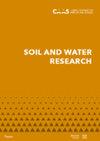Soil water response to rainfall in a dune-interdune landscape in Horqin Sand Land, northern China
IF 1.7
4区 农林科学
Q4 SOIL SCIENCE
引用次数: 2
Abstract
Soil water dynamic is considered an important process for water resource and plantation management in Horqin Sand Land, northern China. In this study, soil water content simulated by the SWMS-2D model was used to systematically analyse soil water dynamics and explore the relationship between soil water and rainfall among micro-landforms (i.e., top, upslope, midslope, toeslope, and bottomland) and 0–200 cm soil depths during the growing season of 2013 and 2015. The results showed that soil water dynamics in 0–20 cm depths were closely linked to rainfall patterns, whereas soil water content in 20–80 cm depths illustrated a slight decline in addition to fluctuations caused by rainfall. At the top position, the soil water content in different ranges of depths (20–40 and 80–200 cm) was near the wilting point, and hence some branches, and even entire plants exhibited diebacks. At the upslope or midslope positions, the soil water content in 20–80 or 80–200 cm depths was higher than at the top position. Soil water content was higher at the toeslope and bottomland positions than at other micro-landforms, and deep caliche layers had a positive feedback effect on shrub establishment. Soil water recharge by rainfall was closely related to rainfall intensity and micro-landforms. Only rainfalls > 20 mm significantly increased water content in > 40 cm soil depths, but deeper water recharge occurred at the toeslope position. A linear equation was fitted to the relationship between soil water and antecedent rainfall, and the slopes and R2 of the equations were different among micro-landforms and soil depths. The linear equations generally fitted well in 0–20 and 20–40 cm depths at the top, upslope, midslope, and toeslope positions (R2 value of about 0.60), with soil water in 0–20 cm depths showing greater responses to rainfall (average slope of 0.189). In 20–40 cm depths, the response was larger at the toeslope position, with a slope of 0.137. In 40–80 cm depths, a good linear fit with a slope of 0.041 was only recorded at the toeslope position. This study provides a soil water basis for ecological restoration in similar regions.科尔沁沙地沙丘间景观土壤水分对降雨的响应
土壤水分动态是科尔沁沙地水资源和人工林管理的重要过程。本研究利用SWMS-2D模型模拟的土壤含水量,系统分析了2013年和2015年生长季0 ~ 200 cm土壤深度的微地貌(顶坡、上坡、中坡、坡脚和洼地)土壤水分动态,探讨了土壤水分与降雨的关系。结果表明,0 ~ 20 cm深度土壤水分动态与降雨模式密切相关,而20 ~ 80 cm深度土壤含水量除了降雨引起的波动外,还略有下降。在顶部位置,不同深度范围(20 ~ 40 cm和80 ~ 200 cm)土壤含水量均接近萎蔫点,部分枝条甚至整个植株出现枯死现象。在坡上和坡中位置,20 ~ 80 cm和80 ~ 200 cm深度的土壤含水量均高于顶部位置。坡脚和洼地土壤含水量高于其他微地貌,深层钙质层对灌木生长具有正反馈效应。降雨对土壤水分的补给与降雨强度和微地貌密切相关。只有>0 ~ 20mm的降雨显著增加了>0 ~ 40cm土壤深度的含水量,但更深层的水分补给发生在坡脚位置。土壤水分与前雨的关系拟合为线性方程,且方程的斜率和R2随微地形和土壤深度的不同而不同。在0 ~ 20 cm和20 ~ 40 cm的坡顶、上坡、中坡和坡脚位置,线性方程总体拟合良好(R2值约为0.60),其中0 ~ 20 cm深度土壤水分对降雨的响应更大(平均斜率为0.189)。在20 ~ 40 cm深度,坡脚位置的响应最大,斜率为0.137。在40 ~ 80 cm深度,仅在趾坡位置录得斜率为0.041的良好线性拟合。该研究为类似地区的生态修复提供了土壤水基础。
本文章由计算机程序翻译,如有差异,请以英文原文为准。
求助全文
约1分钟内获得全文
求助全文
来源期刊

Soil and Water Research
Water resources, Soil Science, Agriculture-WATER RESOURCES
CiteScore
4.60
自引率
0.00%
发文量
26
审稿时长
>12 weeks
期刊介绍:
An international peer-reviewed journal published under the auspices of the Czech Academy of Agricultural Sciences and financed by the Ministry of Agriculture of the Czech Republic. Published since 2006.
Thematic: original papers, short communications and critical reviews from all fields of science and engineering related to soil and water and their interactions in natural and man-modified landscapes, with a particular focus on agricultural land use. The fields encompassed include, but are not limited to, the basic and applied soil science, soil hydrology, irrigation and drainage of lands, hydrology, management and revitalisation of small water streams and small water reservoirs, including fishponds, soil erosion research and control, drought and flood control, wetland restoration and protection, surface and ground water protection in therms of their quantity and quality.
 求助内容:
求助内容: 应助结果提醒方式:
应助结果提醒方式:


